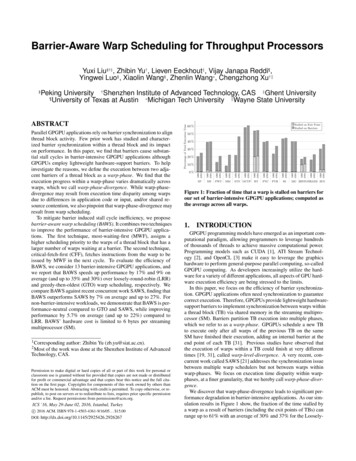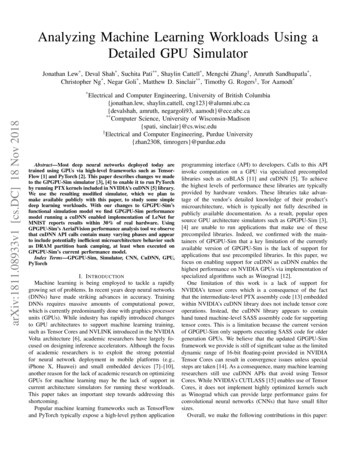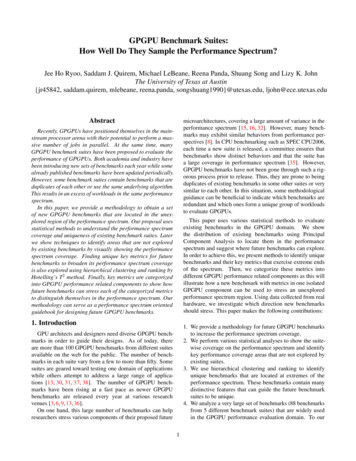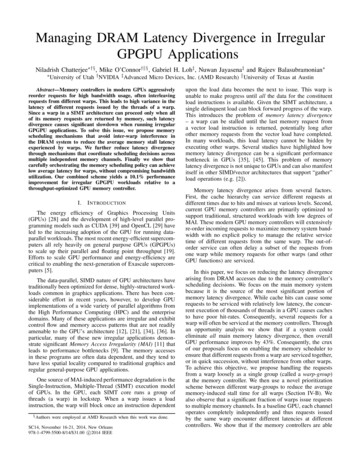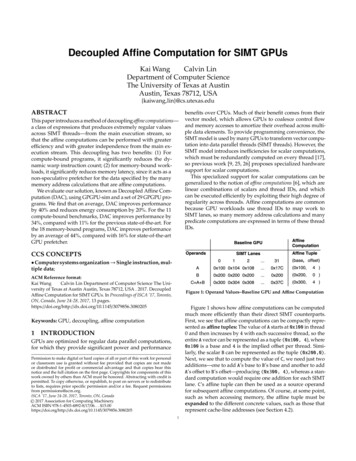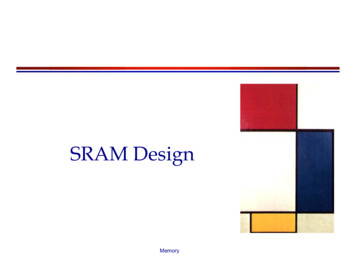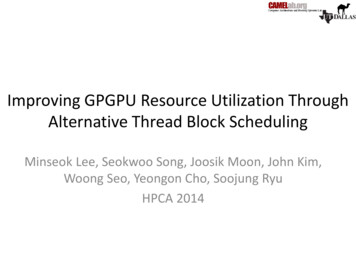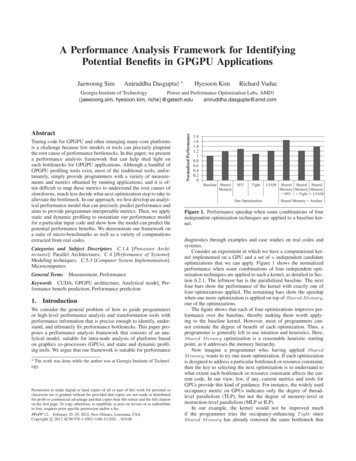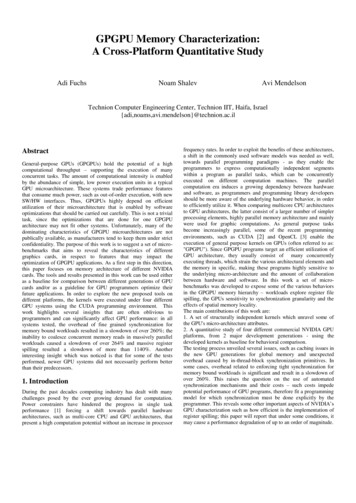
Transcription
GPGPU Memory Characterization:A Cross-Platform Quantitative StudyAdi FuchsNoam ShalevAvi MendelsonTechnion Computer Engineering Center, Technion IIT, Haifa, ractGeneral-purpose GPUs (GPGPUs) hold the potential of a highcomputational throughput – supporting the execution of manyconcurrent tasks. The amount of computational intensity is enabledby the abundance of simple, low power execution units in a typicalGPU microarchitecture. These systems trade performance featuresthat consume much power, such as out-of-order execution, with newSW/HW interfaces. Thus, GPGPUs highly depend on efficientutilization of their microarchitecture that is enabled by softwareoptimizations that should be carried out carefully. This is not a trivialtask, since the optimizations that are done for one GPGPUarchitecture may not fit other systems. Unfortunately, many of thedominating characteristics of GPGPU microarchitectures are notpublically available, as manufacturers tend to keep them under strictconfidentiality. The purpose of this work is to suggest a set of microbenchmarks that aims to reveal the characteristics of differentgraphics cards, in respect to features that may impact theoptimization of GPGPU applications. As a first step in this direction,this paper focuses on memory architecture of different NVIDIAcards. The tools and results presented in this work can be used eitheras a baseline for comparison between different generations of GPUcards and/or as a guideline for GPU programmers optimize theirfuture applications. In order to explore the new proposed tools ondifferent platforms, the kernels were executed under four differentGPU systems using the CUDA programming environment. Thiswork highlights several insights that are often oblivious toprogrammers and can significantly affect GPU performance: in allsystems tested, the overhead of fine grained synchronization formemory bound workloads resulted in a slowdown of over 260%; theinability to coalesce concurrent memory reads in massively parallelworkloads caused a slowdown of over 264% and massive registerspilling resulted a slowdown of more than 1140%. Anotherinteresting insight which was noticed is that for some of the testsperformed, newer GPU systems did not necessarily perform betterthan their predecessors.1. IntroductionDuring the past decades computing industry has dealt with manychallenges posed by the ever growing demand for computation.Power constraints have hindered the progress in single taskperformance [1] forcing a shift towards parallel hardwarearchitectures, such as multi-core CPU and GPU architectures, thatpresent a high computation potential without an increase in processorfrequency rates. In order to exploit the benefits of these architectures,a shift in the commonly used software models was needed as well,towards parallel programming paradigms - as they enable theprogrammers to express computationally independent segmentswithin a program as parallel tasks, which can be concurrentlyexecuted on different computation machines. The parallelcomputation era induces a growing dependency between hardwareand software, as programmers and programming library developersshould be more aware of the underlying hardware behavior, in orderto efficiently utilize it. When comparing multicore CPU architecturesto GPU architectures, the latter consist of a larger number of simplerprocessing elements, highly parallel memory architecture and mainlywere used for graphic computations. As general purpose tasksbecome increasingly parallel, some of the recent programmingenvironments, such as CUDA [2] and OpenCL [3] enable theexecution of general purpose kernels on GPUs (often referred to as:"GPGPU"). Since GPGPU programs target an efficient utilization ofGPU architecture, they usually consist of many concurrentlyexecuting threads, which strain the various architectural elements andthe memory in specific, making these programs highly sensitive tothe underlying micro-architecture and the amount of collaborationbetween hardware and software. In this work a set of microbenchmarks was developed to expose some of the various behaviorsin the GPGPU memory hierarchy – workloads explore register filespilling, the GPUs sensitivity to synchronization granularity and theeffects of spatial memory locality.The main contributions of this work are:1. A set of structurally independent kernels which unravel some ofthe GPU's micro-architecture attributes.2. A quantitative study of four different commercial NVIDIA GPUplatforms, from 2 major development generations - using thedeveloped kernels as baseline for behavioral comparison.The testing process unveiled several issues, such as caching issues inthe new GPU generations for global memory and unexpectedoverhead caused by in-thread-block synchronization primitives. Insome cases, overhead related to enforcing tight synchronization formemory bound workloads is significant and result in a slowdown ofover 260%. This raises the question on the use of automatedsynchronization mechanisms and their costs – such costs impedepotential performance of GPU programs, therefore fit a programmingmodel for which synchronization must be done explicitly by theprogrammer. This reveals some other important aspects of NVIDIA’sGPU characterization such as how efficient is the implementation ofregister spilling; this paper will report that under some conditions, itmay cause a performance degradation of up to an order of magnitude.
Linux kernel version3.2.0-32-generic3.2.0-32-generic2. Related WorkSeveral studies have dealt with GPU micro-architecture behavior;however, this work is the first to combine a quantitative study of fourcommercial GPU systems with benchmarks that are structurallyindependent, making them micro-architecturally neutral, this approachallows the benchmarks created to run on other GPU systems and in thefuture to be easily implemented on other GPGPU programminglanguages (e.g OpenCL). The work of Goswami et al. [4] hasexamined the behavior of a GPU environment for complex workloads(K-means, PCA etc.) to test different aspects, for that they have used asimulation environment (GPGPU-sim) and measured the runtimesunder different configurations. Lashgar and Baniasadi [5] tested theimplications of various control flow mechanisms on GPU memorybehavior under GPGPU-sim as well, they have used CUDA to run aset of known benchmarks (NN, Matrix Multiplication etc.). Unlike theabove mentioned papers, this work targets the pinpointing of specificbehavioral patterns based on the results of synthetic benchmarks thatwere created and executed on real GPU systems. Wong et al [6]created a set of micro-benchmarks targeting various aspects of theNVIDIA GT200 GPU microarchitecture e.g. cache structure, branchdivergence, clocking domains etc. The kernels presented in their worktargeted specific structures in the micro-architecture (for examplecache set structure), while this work contains generic kernels that donot have any structural assumptions (e.g. cache mapping, TPC/SMstructure) on the tested micro-architectures, the affecting parameterswere part of the programming model (e.g. number of threads, numberof synchronization instructions) thus enabling a more extensive study:the kernels' code was compiled and executed in the exact samemanner on the 4 systems tested without any adaptations, enabling themost reliable methodology for comparing various GPU systems.3. Evaluation3.1 PlatformsAll systems run Ubuntu 12.04 on x86 64 architecture, the followingtables contain the hardware configurations extracted using thecudaGetDeviceProperties() runtime function.Table 1. CUDA Capability 2.x machinesDevice NameGPU ArchitectureCUDA Driver/ Runtime VersionCUDA CapabilityGlobal memory sizeMultiprocessorsCUDA Cores/MPTotal number of coresGPU Clock rateMemory Clock rateMemory Bus WidthL2 Cache SizeConstant memory sizeShared memory per blockMax registers per blockWarp sizeMax threads / MPThreads per blockC2070Tesla C2070TeslaQuadro 2000Quadro 2000Fermi5.0 /5.02.06144 MBytes14324481.15 GHz1.5 GHz384-bit786432 bytes65536 bytes49152 bytes3276832153610245.0 /5.02.11024 MBytes4481921.25 GHz1.3 GHz128-bit262144 bytes65536 bytes49152 bytes327683215361024Table 2. CUDA Capability 3.x machinesDevice NameGPU ArchitectureCUDA Driver/ Runtime VersionCUDA CapabilityGlobal memory sizeMultiprocessorsCUDA Cores/MPTotal number of coresGPU Clock rateMemory Clock rateMemory Bus WidthL2 Cache SizeConstant memory sizeShared memory perblockMax registers per blockWarp sizeMax threads / MPThreads per blockLinux kernel versionGTX680GeForce GTX 680KeplerK20Tesla K20mTesla5.0 /5.03.04096 MBytes819215361.06 GHz3 GHz256-bit524288 bytes65536 bytes5.0 /5.03.54800 MBytes1319224960.71GHz2.6 GHz320-bit1310720 bytes65536 bytes49152 bytes65536322048102449152 ic3.2 BenchmarksIn order to get the best performance out of NVIDIA’s cards, this workpresents a new Micro-benchmark suite, using the CUDAprogramming environment – the target of these benchmarks was tomeasure several aspects in cross-platform micro-architecture:structural characteristics such as cache line or pre-fetch sizes for thevarious memory types, and behavioral characteristics such as theeffects of memory coalescing, cache misses, registers file spilling (ascenario in which a kernel's variables cannot fit in the register file andare stored in the memory) and by that provide a rough estimation tothe performance variance between a highly tuned GPU kernel and anhighly unbalanced kernel. For example, many adjacent memory readsfrom different threads can be grouped by the GPU memory schedulerto the same transaction by memory coalescing, while concurrent readsto distinct memory areas cannot be grouped and are performed in asequential manner – resulting in severe performance degradation ofalmost an order of magnitude merely due to bad spatial locality, whichis sometimes oblivious to the GPU programmer.3.3 MethodologyThe notation for benchmark performance in this work is derived fromthe latency perceived by the threads running the kernels, usingCUDA's clock() function. Meaning, all kernels are structured in thefollowing manner: kernel definitions start clock(); kernel execution code end clock();return (start-end);
3.4 Main ResultsThe tests conducted aim to both unveil the implications ofprogramming patterns on the performance of the GPU memoryarchitecture and compare memory architecture related features ondifferent NVIDIA CUDA generations. In specific, these tests highlight4 main aspects in the memory hierarchy:1) The prefetch mechanism of the GPU, which translates into theability of the GPU to exploit spatial memory locality, using its cachemechanisms.2) The overhead of global memory synchronization granularity inmemory intense workloads.3) The contribution of memory coalescing to performance and theimplications on performance for cases in which coalescing cannot beperformed.4) The implications of the register spilling phenomenon that occurs incases for which local variables cannot fit in the register file.3.4.1 Exploring locality different types of memoryThe purpose of this kernel is to discover the sizes and latencyimplications of caching mechanisms, if present. This is done byexamining the effect of 'cold-start' misses – meaning, cache missesresulted from accesses to memory regions never before read. For that,kernels allocate a large array and perform 1024 sequential anddependent reads, divided to 512 couples. Each couple consists of"small jump, large jump" memory accesses: "large jump" is a fixedlarge distance for which no reasonable caching mechanism is designedto perform a pre-fetch (we have used a fixed size of 4KB) the size of"small jumps" varies between 1 and 512 bytes at distinct kernelexecutions. Note that this access pattern also prevents from stridedetection mechanisms, if exist, to perform a pre-fetch. Benchmarksexecute a single kernel at a time since the purpose of this kernel is todiscover variance in latency resulted from a change in locality.Smalljump sLarge Jump 4K-s.Address:01Smalljump ss.Large Jump 4K-s.𝐿(𝑠, 𝑛) returns 1 if the line size of level 𝑛 of the cache is larger than 𝑠.Therefore, 𝐻(𝑠, 𝑛) shall result in 1 if the line size of level 𝑛 of thecache is larger than 𝑠, but all of the cache levels which are closer tothe processor, down to L1, have a smaller cache line size than 𝑠.Given 𝑁 cache levels, and the access time for each cache level 𝑘,𝑇(𝑙𝑒𝑣𝑒𝑙 𝑘), the expected kernel latency for "small jump" stride of size𝑠 should be the following: N T s 512 T MemoryAccess H s, k T level k (2)k 1 long jumpsshort jumps Note that 𝐻(𝑠, 𝑘) returns non-zero result only for one value of 𝑘. Alsomark that after each long jump, a memory access will be needed.Thus, we get that the expected time for the kernel to execute consistsof 512 memory accesses (for the 512 long jumps) and 512 accesses tothe first level of the cache (or memory) which contains the address ofour last access plus our stride 𝑠. In order to refrain from furthercomplicating formula (2) the assumption for the latency in level 𝑘,𝑇(𝑙𝑒𝑣𝑒𝑙 𝑘), is that it includes the latencies of the seek in lower levels.The kernel was executed for 4 different memory types supported bythe CUDA runtime environment: the global memory, the constantmemory, the shared memory and the texture memory.Shared memory:In current GPU systems the shared memory is an on-chip memory,making it potentially faster than other memory types. It is allocatedper thread block, so all threads in the block have access to the sameshared memory. Since the shared memory is relatively small thisspecific kernel contained a relatively small array of 48KB.Shared Memory100Kernel Latency(us)The results extracted from the kernels were scaled from number ofclocks to the actual latency according to the GPU clock rates given inTable 1 and in Table 2. The performance notation in this work wasderived from perceived latencies; if needed, the throughput can bederived as well by combining the perceived latencies with the numberof running threads.All kernels were executed under CUDA runtime version 5.0, compiledusing "-O3" optimization flag ('-Olimit 118245' was sufficient for thekernels containing larger procedures).C2070Quadro2000GTX680K208060402004K 4K 1 4K s41664256small jump size (bytes)Figure 1. The memory access pattern for small jump size S.Figure 2.Execution results for shared memory with varied stride sizesTo more accurately formulate the expected kernel results, thefollowing functions were defined: 1 level ' n ' cacheline sizeis larger than sL ( s, n) otherwise 0n 1H ( s, n) L s, n 1 L s, j j 1(1)As one can infer from figure 2 – for all systems tested, the sharedmemory has a fixed latency – this implies that shared memory is notcached (though it is often used as a user managed cache on softwarelevel). Though original kernels' results were in number of clocks when combining the perceived latency with the clock rates in Table 1and Table 2, it appears that shared memory is around 70% slower forthe new TeslaK20 CUDA system (generation 3.5).
initiate a pre-fetch transaction to request the corresponding 256 bytesline to the L2 cache.Texture memory:Unlike other memory types, Texture memory space is an abstractionprovided by the GPGPU programming environment, rather than aactual memory mapped to a physical device, as described in theCUDA programming guide [8] it is optimized for multidimensionalaccesses and can contain up to 4 coordinates.Global memory:Global memory stores global variables and variables and it can beused both by the GPU and the host (after proper mapping)Global Memory600Texture Memory600C2070Quadro2000GTX680K20500Kernel Latency(us)Kernel mall jump size (bytes)As seen in figure 3 - for all systems tested, texture memory latencyincreased for a step size of 32 bytes, indicating that texture memorycaches a line size of 32 bytes in the first level; this is likely sincetextures in CUDA consist of 4 dimensional coordinates which can beeither long or double precisions (8 bytes each).Constant memory:The constant memory is an on-card memory, containing read-onlydata (i.e. variables and arrays annotated by the reserved 'constant' keyword in CUDA) – the constant memory is accessible to all threads andblocks within a grid.Constant Memory600400643002001000As one can infer from figure 5, the global memory behavesdifferently for the previous generation CUDA systems (2.x). For theprevious generation systems, the latency is increased in step sizes of64 bytes which indicate a first level cache line size of 64 bytes. Fornewer generation systems no latency increase can be seen in thegraphs, indicating the absence of caching mechanism for globalmemory. A possible reason for the lack of global memory caching in3.x devices is due to high memory clock rates comparing to theirpredecessors, as mentioned in tables 1 2 – this suggests that the GPUmanufacturers for CUDA devices with generations favored higherfrequency memories over caching mechanisms.3.4.2 The effects of local thread synchronization"1024 Memory writes, N syncs" kernel execution code41664small jump size (bytes)256small jump size (bytes)This kernel explores the overhead caused by synchronizing threads fora memory bound workload, consisting solely of memory writes. Thekernel performs 1024 memory accesses and using CUDA'ssyncthreads() to synchronize threads belonging to the same blocks.The parameter being changed here is N number of syncthreads()instructions, as N increased – so is the frequency of synchronizationinstructions, starting from N 1 ( syncthreads() is called only at theend of all 1024 accesses) and reaching N 1024 ( syncthreads() iscalled after every memory access) - given a general N the kernelexecution code is structured in the following manner:C2070Quadro2000GTX680K2050016Figure 5. Execution results for global memory with varied stride sizesFigure 3.Execution results for texture memory with varied stride sizesKernel Latency(us)C2070Quadro2000GTX680K20256Figure 4.Execution results for constant memory with varied stridesizesFor all systems tested, Latency change for constant memory in 2distinctive points - in 64 bytes and 256 bytes, implying that constantmemory has 2 levels of cache – the first of 64 byte line size, thesecond level is 256 bytes. Previous studies exploring the GT200 GPUsystem [7] reveal that GT200 has an L2 cache line of size 256 bytes –if this is the case here, it implies that upon access the GPU systemsboth loads the corresponding 64 bytes line into the L1 cache and𝑎𝑟𝑟[0] 𝑝 ;𝑎𝑟𝑟[1] 𝑝 ; 𝑎𝑟𝑟[(1024/𝑁) 1] 𝑝 �𝑟𝑟[1024/𝑁] 𝑝 ;𝑎𝑟𝑟[(1024/𝑁) 1] 𝑝 ; 𝑎𝑟𝑟[(2 1024/𝑁) 1] 𝑝 ;𝑠𝑦𝑛𝑐𝑡ℎ𝑟𝑒𝑎𝑑𝑠();
CUDA 2.x systems:Tesla C20709080Kernel Latency (us)6050GTX 680601 thread4 threads32 threads64 threads128 threads192 threads50403020101 thread4 threads32 threads64 threads128 threads192 threads70CUDA 3.x systems:Kernel Latency (us)As N increases, the overhead of memory synchronizations increaseaccordingly, in a sense one can perceive N 1024 as fine grainedsynchronization (synchronization performed after every memoryaccess) performed for benchmarks with high memory traffic. Thebenchmarks were executed several times - both for varied number ofsynchronizations and for varied number of threads. All threadsexecute the abovementioned kernel code on the same array, mapped tothe global memory; by enforcing such workload with variedsynchronization frequency this benchmark targets a quantification ofthe overhead caused by global memory synchronization in a memorybound workload01416642561024#Sync instructionsFigure 8. Latency of 1024 global memory writes w.r.t the frequencyof synchronization instructions for Kepler GTX680.4030K202090108001 thread4 threads32 threads64 threads128 threads192 threads41664#Sync instructions2561024Figure 6. Latency of 1024 global memory writes w.r.t the frequencyof synchronization instructions for Tesla C2070.Fermi Quadro 200010090807060504030201004Kernel Latency (us)6050403020101 thread4 threads32 threads64 threads128 threads192 threads1Kernel Latency (us)7010141664#Sync instructions2561024Figure 9. Latency of 1024 global memory writes w.r.t the frequencyof synchronization instructions for Tesla K20.16642561024#Sync instructionsFigure 7. Latency of 1024 global memory writes w.r.t the frequencyof synchronization instructions for Fermi Quadro 2000.When looking at figures 6-9 one can deduct that a change in thenumber of concurrent threads increases latency by a maximum of13% for Fermi Quadro 2000, 11% for Tesla C2060, 38% for TeslaK20 and 6% for Kepler GTX 680, while the increase in the frequencyof synchronization instructions (up to one for each memory write)increases latency by 163% for Fermi Quadro 2000, 178% for TeslaC2060, 223% for Kepler GTX 680 and 281% for Tesla K20. Thisclearly demonstrates the magnitude of overhead resulted from finegrained synchronization in high memory bound benchmarks, harmingboth latency and throughput thus impeding the gain from a highnumber of threads. It can also be inferred that Kepler GTX680demonstrated the best performance, while the Tesla K20 GPU, whichis a more advanced device, suffered from some fluctuations andperformed worse.
Tesla C20703.4.3 The effects of memory coalescingIn order to examine the behavior under various concurrent globalmemory access patterns, threads executing this kernel invoke asequence of 1024 read instructions from adjacent addresses, eachthread starts from a different offset – by changing the number ofthreads and the size of the offset, this micro-benchmarks simulatesvarying stress on the memory scheduler, as well as examining the sizeof the coalescing window."1024 reads varied offset" kernel execution code:start thread id*offset;for (i 0; i 1024; i ) read(array[start i])Average read latency ThreadsoffsetThread2Figure 12. 1024 consecutive memory with varied threads staringpoints w.r.t number of threads for Tesla C2070Thread 1offsetCUDA 3.x systems:Thread 0.offset.1K-1 1K 1K offsetFigure 10. Memory coalescing benchmark flow for 3 threadsThe cross-thread offset was changed from 4 bytes (high adjacencybetween threads, the memory scheduler can coalesce several threadsreads) to 1KB (all threads read from distinct memory areas)Average read latency (us).Address: 0 1Kepler GTX6801.4Tesla C2070 Fermi Quadro tes512bytes0.2141664256#ThreadsFigure 13. 1024 consecutive memory with varied threads staringpoints w.r.t number of threads for Kepler GTX 6808bytes16bytes32bytes1Tesla bytes1024bytes0.40.201416#Threads64256Figure 11. 1024 consecutive memory with varied threads staringpoints w.r.t number of threads for Fermi Quadro 2000Average read latency (us)Average read latency (us)16bytes104bytes1.28bytes1.2Fermi ThreadsFigure 14. 1024 consecutive memory with varied threads staringpoints w.r.t number of threads for Tesla K20
The issues that can be inferred from the above figures are as follows:1. Latency increases as a function of the number of threads – sincenot all memory transactions that are invoked concurrently can beexecuted concurrently via coalescing.CUDA 2.x systems:Fermi Quadro 20002. The latency increases as the offset increase – a larger offsetreduces the spatial locality between threads, therefore the ability tocoalesce their memory transactions. The overhead of high offsetcombined with many concurrently executing threads was 898% forthe C2070 system, 770% for the Fermi Quadro 2000 system, 443%for the Kepler GTX680 system and 263% for the Tesla K20 system.4. The increase in latency plateaus for 32 threads in 3.x systems andin addition, overall latency is higher than the latency of 2.x systems –the reason for that probably also lies in the absence of cachemechanism for 3.x systems: without the ability to coalesce reads, andwithout any cache structure, 3.x systems perform worse than their 2.xcounterparts, under memory bound workloads and no ability tocoalesce the accesses to the 005000141664256ThreadsFigure 15. 4096 reads and writes with varied number of longvariables w.r.t number of threads for Fermi Quadro 2000Tesla C20703.4.4 The effects of register 2048vars3500Kernel Latency(us)When a program has more live variables than the machine hasregisters, some variables are "spilled" from the register file into thememory. The purpose of this benchmark is to quantify the effects ofregister spilling, by changing the number of long variables defined inthe kernel. Since too many variables cannot fit in the register file at agiven time, they shall be stored in the memory that will be used as anextension to the register file. In order to prevent the compiler fromoptimizing the code and group the variables, the variables are loadedand stored in a random order, thus creating a dependency tree which istoo complex to be resolved for a large enough number of variables.Below is the pseudo code for the benchmark kernel, for which Xrepresents the number of variables.4vars128vars2048vars4000Kernel Latency(us)3. The increase in latency plateaus for 16 threads in both 2.x systems.The probable reason is caching – since all threads perform serialreads, as number of threads increase so is the number of linesconcurrently loaded to the global memory cache (therefore threadscan use data pre-fetches earlier by other threads). An additionalincrease in latency is spotted starting 128 threads for both systems,for offsets larger than 32 bytes. The reason for that is a global cachefill-up, which is caused by the increasing of both the offset size andthe number of threads, which together enlarge the effective workingset, crossing the maximal cache set capacity. The loss of localitycauses performance degradation of up to 650% in both systems(comparing to the executions with 4 bytes strides).1vars3000250020001500100050001Kernel definition code: define X long variables initialized to random values Long v;kernel execution code:𝐷𝑂 4096:𝑣 𝑥𝑖 ; / (𝑥𝑖 𝑖𝑠 𝑎 𝑟𝑎𝑛𝑑𝑜𝑚𝑙𝑦 𝑐ℎ𝑜𝑠𝑒𝑛 𝑣𝑎𝑟𝑖𝑎𝑏𝑙𝑒) /𝑥𝑘 𝑣; / (𝑥𝑘 𝑖𝑠 𝑎 𝑑𝑖𝑓𝑓𝑒𝑟𝑒𝑛𝑡 𝑟𝑎𝑛𝑑𝑜𝑚𝑙𝑦 𝑐ℎ𝑜𝑠𝑒𝑛 𝑣𝑎𝑟𝑖𝑎𝑏𝑙𝑒) /41664256ThreadsFigure 16. 4096 reads and writes with varied number of longvariables w.r.t number of threads for Tesla C2070
When re-examining tables 1 2, there are 32 threads per warp. Thisindicates that the combination of multiple warps with large numberof variables stresses the register file.CUDA 3.x systems:Kepler 48varsKernel readsFigure 17. 4096 reads and writes with varied number of longvariables w.r.t number of threads for Kepler GTX 68040004vars512vars32vars1024varsKernel Latency(us)350030002500200015001000500014163. For 32 threads and less, the increase in the number of concurrentlyrunning threads does not significantly affect performance for a smallenough number of variables. Thus, the dominating factor forperformance is the number of variables (and registers) used implying that all systems allocate per-thread registers to storevariables. For more than 32 threads, the dominating factor was stillthe number of variables but an additional increase in latency is seenas number of threads increase, indicating an overhead of a possiblearbitration mechanism between executing warps.4. When examining single thread performance, one can notice thatfor 2048 long variables (total size of 16KB), there is a significantslowdown of about 1140%. As shown in Table 1 and Table 2, thisamount of data can easily fit in standard cache memories. However,as it appears in the figures, the considerable slowdown caused by theregister spilling implies that all of the GPU systems that were testeddo not cache the spilled variables, but just save them in anothermemory (slower than the cache) instead.4. ConclusionsTesla K201vars128vars2048vars2. For all systems except the K20, the significant increase in latencystarted when the number of variables crossed 64, regardless of thenumber of threads - implying that most systems support a register filethat is able to store 64 user variables (512B of storage) per thread.For the TeslaK20 system, the significant increase started for 512bytes – this suggests that the K20 allocates for larger storage forvariables than its predecessors (although table 2 states both GTX 680and K20 has the same register file size).64256ThreadsFigure 18. 4096 reads and writes with varied number of longvariables w.r.t number of threads for Tesla K20When examining the above results, some trends can be extractedfrom the figures above:1. For all systems, the latency has been increased for benchmarkswith large number of variables – the phenomenon was even moresignificant in cases for which number of threads was more than 32.In this work several GPGPU benchmarks were written in the CUDAprogramming environment. The target was to provide a way forpinpoint the strengths and pitfalls in current commercial GPUsystems with an emphasis on the memory hierarchy – thesebenchmarks are structurally independent, as there were noassumptions on any internal hardware structures or cache mappingschemes. This made it natural for the benchmarks to be executed onmultiple GPU systems and motivated the cross-platform comparisonmade in this work, given 4 different NVIDIA GPU systems. Thestructural independence approach also made the benchmarks codehighly robust, as it can be easily re-wri
simulation environment (GPGPU-sim) and measured the runtimes under different configurations. Lashgar and Baniasadi [5] tested the implications of various control flow mechanisms on GPU memory behavior under GPGPU-sim as well, they have used CUDA to run a set of known benchmarks (NN, Matrix Multiplication etc.). Unlike the
